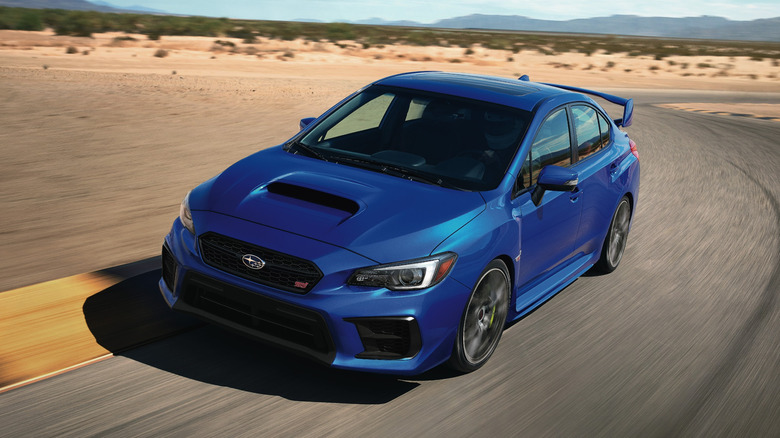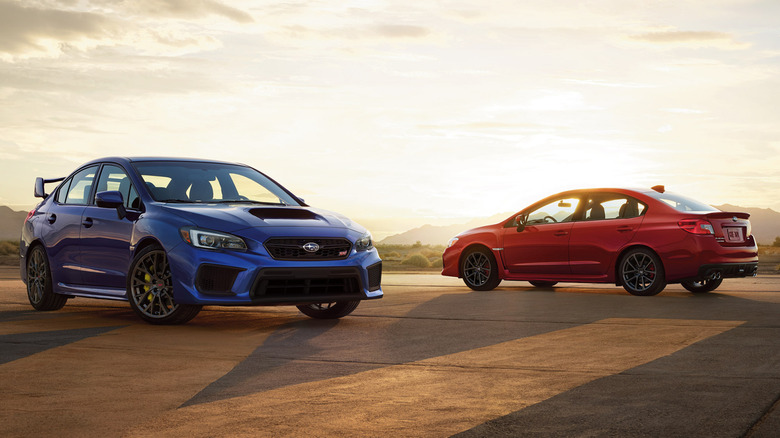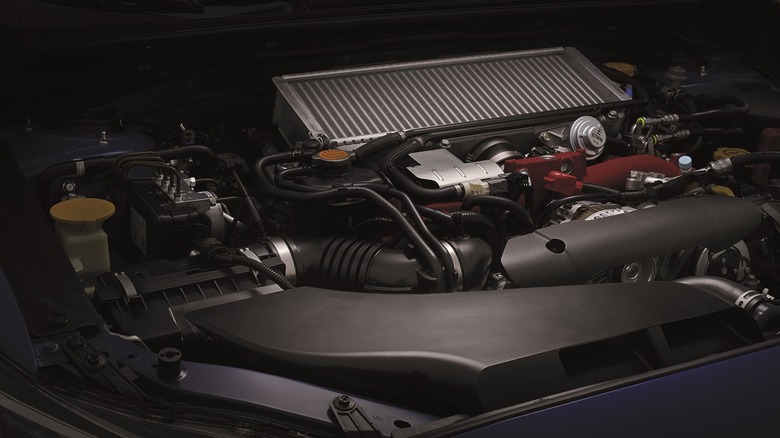Subaru Could Make A V6 Engine – Here's Why It Doesn't
Typically, when one pictures a passenger car engine with two heads, the first thought that comes to mind is a V6. These ubiquitous engines are almost universally found within just about every major manufacturer's sales brochures, with only a few notable exceptions. For instance, you have BMW, which still uses a straight-six mounted at an angle. But for the most part, a V6 represents a good marriage between adequate power and compact size. It's small enough to fit lengthwise inside most engine bays while leaving room for accessories, and short enough to not require a tall hood line. But like BMW, Subaru apparently never got that memo.
A boxer engine, also commonly referred to as a flat engine (flat-four or flax-six), or an H-engine, features two banks of opposed pistons that are directly across from one another — each cylinder bank faces opposite directions. In Subarus, they face to the left and right, respectively, a longitudinal configuration. Many cars utilize boxer configurations, from the classic Volkswagen Beetle's H4 to the Citroën 2CV's H2. But Subaru remains the only manufacturer to build an entire corporate identity around this configuration. Why did they do it, though?
The answer rests in the engine's core strengths, namely its low center of gravity, short length, flat nature providing certain safety benefits, and no vibration in the vertical plane. In other words, it's a combination of performance benefits and design choices which favor the boxer configuration if, for instance, the car is involved in a head-on impact, in addition to properties inherent to the physics at play. Let's take a look under the hood and see how Subaru makes it work and what advantages it offers when compared to a V6.
The advantages of using a boxer
Subaru domestically uses five engine families across its model range, some having four cylinders, others six. But one thing they all have in common: they're boxer engines. Apart from oddball engines featured in some JDM models like the Justy, powered by a 1.0L inline-3, or historical examples like the two-cylinder Subaru 360; every Subaru you see has a boxer. Subaru used these engines since the 1960s, with today's models featuring highly-refined and robust designs favoring fuel efficiency, performance, and safety. For instance, Subaru builds cars in such a way that the engines are placed low into the chassis, meaning in a heavy front-end accident, the block goes beneath the car rather than punching through the dashboard. A lower frontal profile also allows for a more streamlined shape and less frontal cross-section, further boosting efficiency.
Because the pistons sit on the same horizontal plane, all the heavy bits of the engine (block, heads, etc.) are some of the lowest-placed components in the car. Placing all the weight far down improves a car's center of gravity; it's less likely to experience body roll with this weight distribution. This provided an inherent performance advantage for rally as well, which Subaru excelled at for decades with cars like the Legacy and Impreza.
The boxer design also favors the Subaru further down the drivetrain as well. Its relatively short size and longitudinal configuration means the AWD system sits directly behind the engine, keeping the balance towards the middle of the car and allowing for a shorter front end. This contrasts with certain transverse engine Audis and Mitsubishis, for instance, which have their respective AWD mechanisms in the back.
Why keep it for so long?
Of course, for every benefit of a certain engine type, there will likely be deficits. Boxer engines are the widest possible engine type by their nature, being exactly 180 degrees from side to side. They are quite simple in that they don't need balancing shafts; they have perfect balance characteristics owing to their design architecture — but that architecture can be a pain to work on. For instance, the engine's spark plugs are notorious for being tricky to service because of the tight confines, especially for beginners. Lastly, the engines are sometimes prone to overheating and subsequent head gasket issues because of the difficulties involved with cooling this configuration adequately.
Despite these issues, however, Subaru have effectively crafted an entire image around this very configuration, owing to a number of idiosyncrasies. For example, especially in performance vehicles and those with modifications, boxer engines produce a distinctive "rumble" sound from unequal-length headers, which cause exhaust gases to "bunch up" and produce a burbly effect. Its design also places less load on the crankshaft, allowing the engine to accept forced induction without many issues; many Subaru engines are indeed turbocharged, with the turbo sounds synonymous with that high-performance vibe.
Overall, then, Subaru largely uses boxer engines for the same reasons as Mazda used its Wankel rotary or BMW uses straight six: because it's iconic, and the company created designs which specifically favored that configuration. The term "boxer engine" cannot realistically be divorced from Subaru at this point, and it's an image which has resonated within the enthusiast community for decades, with no signs of stopping anytime soon.


